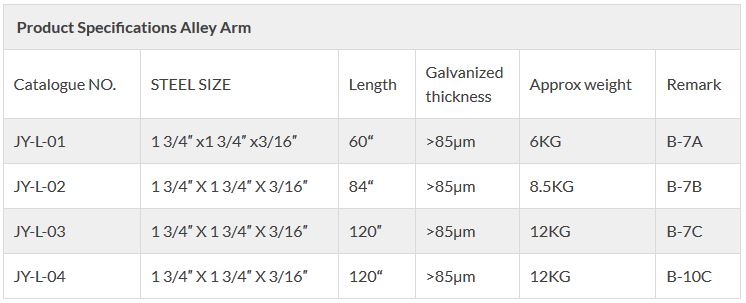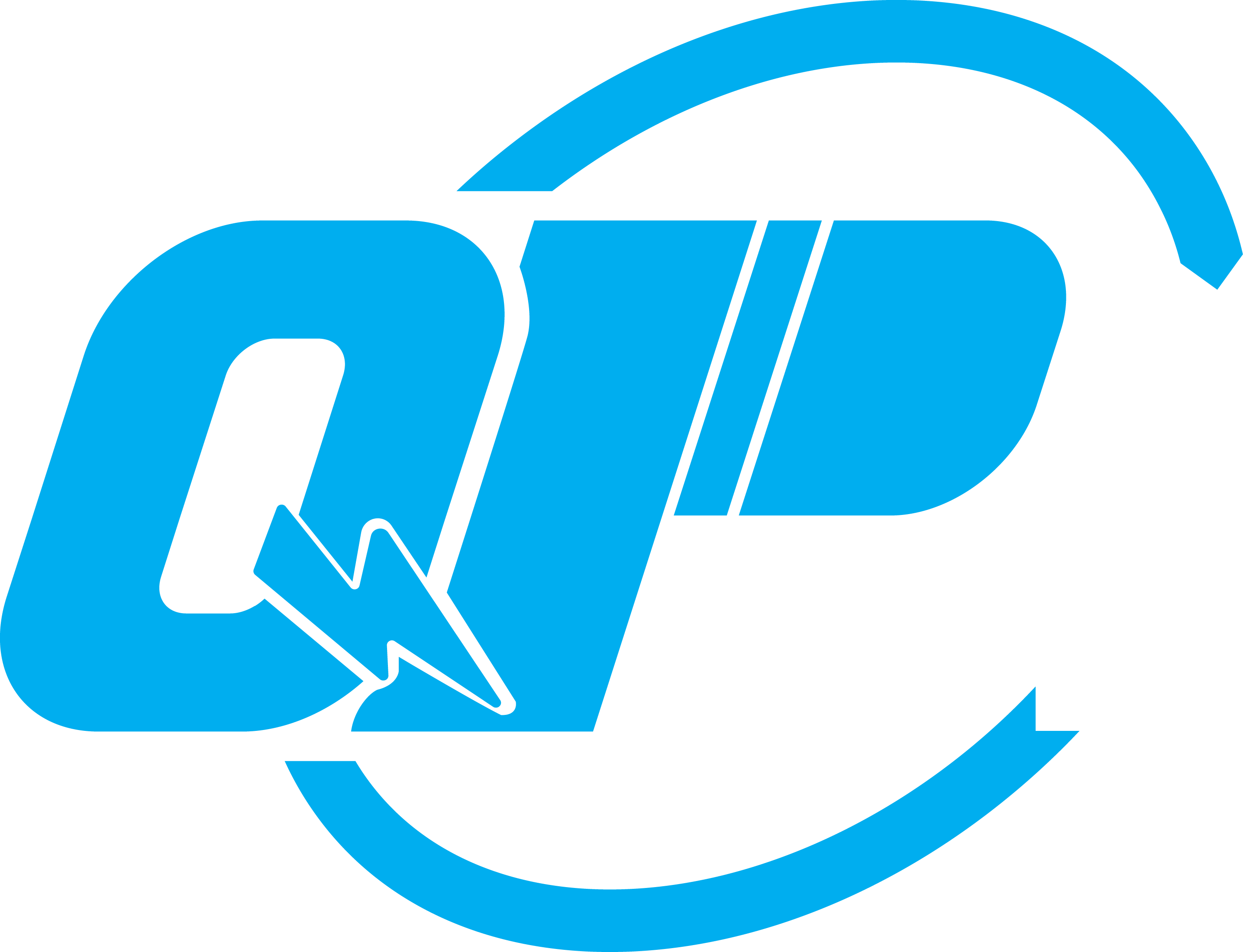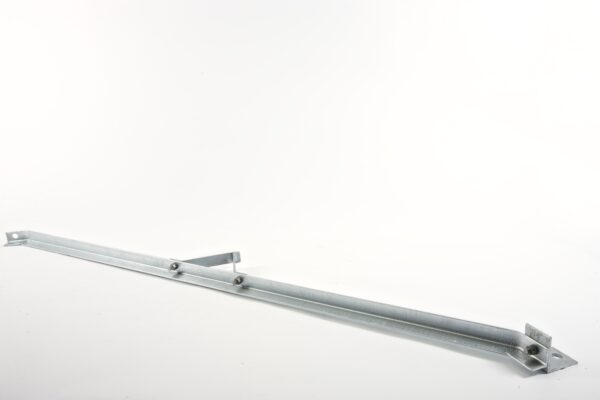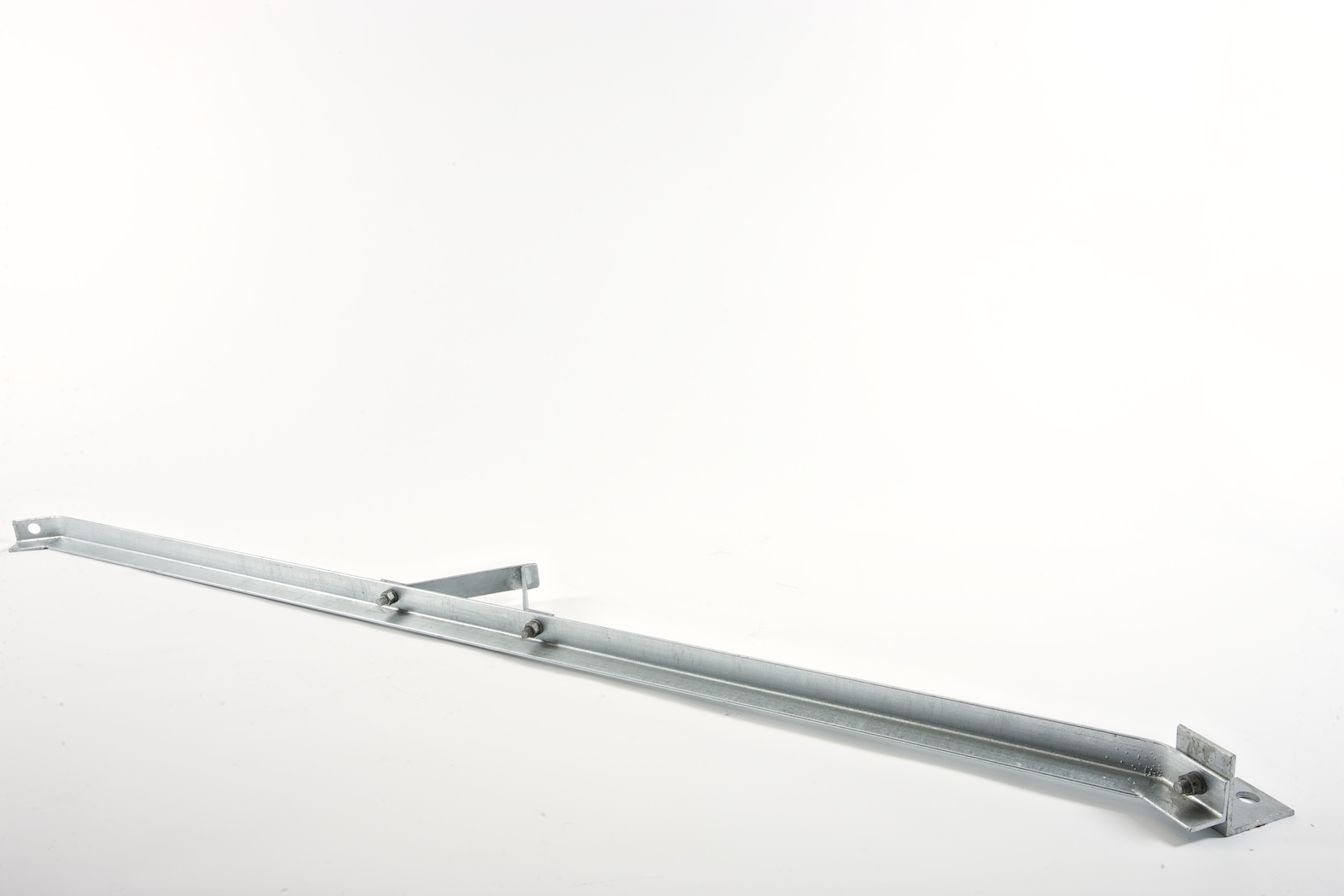Alley Arm
- Description
- Specification
Description
The alley arm is one complex type of steel cross arm, it is also called side arm or alley arm brace. The alley arm is widely used on overhead lines, utility poles, power poles, and light poles.
The alley arm is installed with the off-side steel cross arm and the pole as a triangular shape so that it will support the off-side steel cross arm firmly.
The alley arm can be installed both at the left side or right side of the power pole cross arm. Both ends of the alley arm angles are beat closed, the 90-degree angle will become zero angles.
After beating closed, the closed side will be bent to another angle. This angle will help to connect easily with the off-center steel cross arm. In the middle of the alley arm, there is a lineman step. During installation, the lineman will step on this triangular strap, protecting it from slipping.
The raw material for the alley arm is selected according to BS4360 standard, The main raw material is angel steel, and there is 60, 84 and120’’ length to choose from. All the alley arm raw materials before and after fabrication are straight and free from blisters, scale, and other defects.
The finish of the alley arm brace is hot dip galvanized. After hot dip galvanization, the surface of the alley arm brace will be smooth, bright, and continuous. The hot dip galvanized part will be tested by the Quan Pham Industry QC team according to standard ASTM123-78.
Quan Pham Industry as an experienced steel cross arm manufacturer and supplier has solved all the problems in alley arm production.
Contact us now!
Table of Contents
Alley Arm: The Complete Guide
Alley arm hardware is common on utility poles, light poles, overhead lines, and power poles.
However, for efficient and reliable distribution or transmission, you must go for a high-quality alley arm.
And, today, I am going to show you how to shop for the right alley arm.
I will take you through basic definitions, applications, parts, technical specifications, and installation processes.
Guess what?
By the end of this guide, you’ll be an alley arm expert.
Okay, let’s delve in for more information.
What is Alley Arm?
An alley arm is simple and useful pole line hardware.
This accessory looks like this:

Alley arm
An alley arm is also known as an alley arm brace.
They are metallic plates or components, with one straight edge with the other slightly bent.
Normally, you can use an alley arm on one side of a pole to ensure proper alignment in power distribution and transmission lines.
In most cases, you can mount the alley arms at an angle of 45 degrees to the pole.
Alley arms are common accessories on utility poles, power poles, overhead lines, and light poles.
So, why exactly should you buy alley arms?
Main Applications of Alley Arm
The alley arm has many applications that may range from overhead lines to utility poles.
In this section, I am going to take you through some of the most common applications. They include:
a) Overhead Lines and Power Poles
Alley arms help to keep overhead lines stable by providing the needed support.
As a result, it helps to keep all other pole line hardware in place, making it easier for power transmission and distribution.
b) Utility poles
Installing cables and other hardware on utility poles can be a complicated process.
And, this is where an alley arm comes in to provide the much-needed support.
c) Lighting Poles
It is yet another common application of alley arms.
For instance, whenever you’re installing a street light arm, you may need an alley arm for support.
In short, an alley arm plays an important role in the transmission and distribution lines.
Main Parts of Alley Arm
Every hardware accessory has unique parts that make it unique.
However, an alley arm is a simple pole line hardware – and this is quite clear from the image below.

Slanting alley arm
Now, some of the main components of alley arms include:
i. Holes for Lag Screws
You will use the lag screws to fix the alley arm.
Depending on the nature of the application, you can choose from different designs and sizes of lag screws.
These screws help to tighten and fix other pole line accessories.
That is, they may help to keep cables, insulators or other accessories in place.
Always make sure you choose the right hole sizes.
It will make your installation simple and easy.
ii. Channel
The size of the channel is very important.
For transmitting and connecting cables on power lines, utility poles, and others, alley arm channels play an important role.
Channels direct these transmissions the right way.
It makes your installation easier and simple.
As a rule of thumb, you need to know the nature of the application at hand to choose an alley arm with the right channel.
iii. Holes for machine bolt
Alley arm brace is mounted to the side arms of machine bolts.
They are then connected to the pole with ½” lag screws.
Again, you must choose an appropriate size and type.
Remember, they also play an important role when it comes to providing the necessary support.
Technical Specifications of Alley Arms
Now, this is yet another critical aspect you must consider before buying alley arms.
Material Type
The raw material for this hardware accessory is angle steel.
The raw material for this hardware accessory is chosen based on the BS4360 standard.
Of course, depending on other applications, you can find an alley arm made from aluminum or wood.
But more importantly, you must pay attention to the stipulated standards.
Why?
They are straight and free from scale, blisters, and other defects.
Dimension (length, width, and thickness)
Alley arms come in different lengths such as 60”, 84”, and 120”.
The width and thickness, as well as length, also vary depending on the specific applications.
Finishing
Its finish is hot-dip galvanized.
After this hot dip galvanization, the surface of alley arms becomes smooth, continuous, and bright.
The hot-dip galvanization must conform to the ASTM123-78 standard.
Don’t buy an alley arm brace that doesn’t meet this standard.
Weight
The weight of an alley arm always varies.
So you need to place orders based on your specific need for it.
Generally, it is not heavy.
That is one thing you should be happy about. Its light weight, making installation easy and simple.
Alley arm design
An alley arm looks roundish-straight in the middle.
It, however, has straight edges.
At their edges, one side is mostly straight and the other slanted.
Both ends of these hardware accessory angles are closely beat.
Its 90° angle will now become a 0 angle.
The design of the alley arm is what makes it very easy to use.
Remember, the design will also vary depending on the application.

Technical specification of alley arm
Step-by-step How to Install an Alley Arm
Now, it is time to install an alley arm.
The truth is – the installation process may vary from one application to another.
However, the general procedure will remain somehow the same.
 Technical drawing of alley arm
Technical drawing of alley arm
Also, installing alley arm is a simple and easy process.
Let’s do this:
- First, have all the necessary tools and equipment to do the job. These will include safety gear and fastening tools or equipment.
- Assess the alley arm before the installation begins. Ensure it is made from the right material, length, width, finish, etc. Just ensure it meets the right specifications.
- Now, ensure you position the alley arm properly on the pole line. You will find some alley arms with a triangular strap – make sure you position it properly.
- Now, you can install alley arm with an off-side steel cross arm (the pole as its triangular shape). It is to ensure alley arm supports off side steel cross arm steadfastly.
- Make sure the alley arm is rigid bracing on one side of the pole. This will ensure the right level of alignment and power distribution as well as transmission lines.
- You should ensure all fasteners are tight to ensure the pole line hardware is stable for any distribution.
- Depending on the nature of the application at hand, you may install an alley arm on both sides of the pole.
Conclusion
As you can see, an alley arm is a simple pole line hardware, yet it plays an important role in the transmission and distribution systems.
More importantly, whenever you’re buying an alley arm, choose one with the right specifications.
That is, it should be of the right material, dimension and finish – refer to its technical specifications.
At Quan Pham Industry, we design and manufacture high-quality alley arms for transmission and distribution lines.
Talk to us today in case you need any pole line hardware.
FAQ
What is an alley arm?
Alley arm is also named alley arm brace, it is a fitting used on one side of a pole to ensure proper alignment in power distribution and transmission lines.
Where are steel alley arms used?
Here are some common applications:
- Overhead Lines and Power Poles
- Utility poles
- Lighting Poles
What critical aspects i need to consider when buying alley arms?
Here are some technical specifications you need to check:
- Alley arm design
- Material Type
- Dimension (length, width, and thickness)
- Galvanizing
- Weight
How to Install an alley arm?
- Ensure the technical specifications are right.
- Prepare the necessary tools and equipment.
- Make sure you position it properly.
- Install alley arm with off-side steel cross arm
- Make sure the alley arm is rigid bracing on one side of the pole.
| Product Specifications Alley Arm | |||||
| Catalogue NO. | STEEL SIZE | Length | Galvanized thickness | Approx weight | Remark |
| JY-L-01 | 1 3/4″ x1 3/4″ x3/16″ | 60“ | >85µm | 6KG | B-7A |
| JY-L-02 | 1 3/4″ X 1 3/4″ X 3/16″ | 84“ | >85µm | 8.5KG | B-7B |
| JY-L-03 | 1 3/4″ X 1 3/4″ X 3/16″ | 120″ | >85µm | 12KG | B-7C |
| JY-L-04 | 1 3/4″ X 1 3/4″ X 3/16″ | 120“ | >85µm | 12KG | B-10C |









